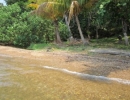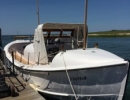
At the Point of a Cutlass
The Pirate Capture, Bold Escape, and Lonely Exile of Philip Ashton
“Delivers blood-thirsty pirates and plenty of action and excitement on the high seas. ...In Ashton’s story, Flemming struck it rich.”
--- Boston Globe
“Paints an indelible picture of pirate life, day by day... compelling, dramatic reading.”
--- Dallas Morning News
Prologue
July 19, 1723
Exactly one week before he died, Joseph Libbey stood in court and pleaded his innocence. Libbey had shown the judges a year-old copy of the Boston News-Letter, from July 1722, that contained depositions by the captains of three fishing vessels. Those statements, sworn under oath, attested that Libbey was a forced man. But over past thirteen months, Joseph Libbey had made enough mistakes for the witnesses who testified in court to claim he was in fact guilty of being an active member of a pirate crew that had been terrorizing the Atlantic coast. Libbey fired guns during the pirates' attacks on other ships, the witnesses said. He was a "stirring, active man among them" and had been seen going aboard captured vessels in search of plunder.
The gallows was erected on the long, narrow bar of sand and rock that formed Gravelly Point, at the edge of the harbor in Newport, Rhode Island. A large crowd of people had come to watch the condemned men die—not only Libbey, but twenty-five others accused of being pirates. Libbey was one of the youngest of the men, just twenty-one or twenty-two years old that summer. Before his capture he had been a fisherman from the small village of Marblehead, Massachusetts, where he had grown up. Like some of the other men who stood with him at the gallows, Libbey claimed he was the victim of cruel circumstances. He had not chosen to sail with the pirates; he and many of the others had, in one captive's words, gone with "the greatest reluctancy and horror of mind and conscience." In time, however, Joseph Libbey must have given in to the crew's brutality—the threats, whippings, and beatings—and began helping out when the pirates attacked other vessels at sea.
 The execution was held shortly after noon on Friday, July 19, 1723. A local minister, Nathaniel Clap, said a final prayer. After that, it was time. Libbey stood on the gallows while a rope was placed around his neck, the thick knot of the noose positioned to the side of his head, under the ear, which was thought to be the most effective placement. When the bodies of the convicted pirates dropped, the ropes snapped tight—but only a few of the twenty-six men died instantly. The rest strangled for a minute or two longer, convulsing and gasping for air as they swung from the ropes. The crowd stood watching the morbid spectacle unfold. The eyes of the men bulged from their heads as they hanged, their lips slowly turning purple. "Oh!" a witness wrote afterwards. "How awful the noise of their dying moans." Finally, the ropes gripping the men's necks cut off the supply of blood to their brains and the flow of air to their lungs, and they died. When the sun set on Newport that day, the spectators had witnessed history, one of the largest mass executions ever held in the nearly two hundred years of the American colonial era.
The execution was held shortly after noon on Friday, July 19, 1723. A local minister, Nathaniel Clap, said a final prayer. After that, it was time. Libbey stood on the gallows while a rope was placed around his neck, the thick knot of the noose positioned to the side of his head, under the ear, which was thought to be the most effective placement. When the bodies of the convicted pirates dropped, the ropes snapped tight—but only a few of the twenty-six men died instantly. The rest strangled for a minute or two longer, convulsing and gasping for air as they swung from the ropes. The crowd stood watching the morbid spectacle unfold. The eyes of the men bulged from their heads as they hanged, their lips slowly turning purple. "Oh!" a witness wrote afterwards. "How awful the noise of their dying moans." Finally, the ropes gripping the men's necks cut off the supply of blood to their brains and the flow of air to their lungs, and they died. When the sun set on Newport that day, the spectators had witnessed history, one of the largest mass executions ever held in the nearly two hundred years of the American colonial era.
- - - - -
Two thousand miles away from New England on that summer day, another young man was sitting alone on the ground, surrounded not by a crowd of spectators but by utter solitude. He gazed out at the empty blue sea from a small cay that was no more than a few hundred yards off a remote island at the western edge of the Caribbean. The island had once, long ago, been inhabited by native people, and again later by a small group of British colonists who tried to build a plantation there but failed and left after just a few years. By 1723, the island was wild and desolate, overgrown and uninhabited for the past seventy-five years.
The man who was stranded along its quiet, windswept shore was named Philip Ashton. Four months earlier, Ashton had run for his life into the thick, jungle-like woods of the island when his ship stopped there for repairs and fresh water. Now Ashton was completely alone, and the odds of survival were against him. He had no knife, no gun, and no way to make a fire. He was hungry and growing weaker by the day. He hadn't eaten a cooked meal since he'd escaped on the island and was barely surviving on whatever fruit he could find growing on trees and the raw turtle eggs he could dig out of the sand. "Everything," Ashton later recorded, "looked with a dismal face." Ashton's condition would continue to worsen and within a matter of months, Ashton would be so starved and sick that he would be close to death.
 These two men—Joseph Libbey and Philip Ashton—were friends. They had worked together on the same fishing schooner that sailed out of the village of Marblehead in what was then the Massachusetts Bay Colony. Less than a year earlier, Libbey had reached his hand over the side of a boat and saved Ashton from drowning. They had been together on one of the most terrifying nights of their lives, a quiet Friday evening in June 1722, when Ashton and Libbey were attacked and forced to go aboard the pirate ship. They came face-to-face with a raving-mad pirate captain, Edward Low, who captured more ships and killed more people than even Blackbeard—often by hacking the lips or ears off his victims or slaughtering them and roasting their hearts over a fire. It was during their cruise with the pirates across the Atlantic and back that Ashton and Libbey parted ways. By the end of July 1723, Joseph Libbey had been accused of being a member of the vicious pirate crew, and was dead. Philip Ashton was trying to figure out how to survive.
These two men—Joseph Libbey and Philip Ashton—were friends. They had worked together on the same fishing schooner that sailed out of the village of Marblehead in what was then the Massachusetts Bay Colony. Less than a year earlier, Libbey had reached his hand over the side of a boat and saved Ashton from drowning. They had been together on one of the most terrifying nights of their lives, a quiet Friday evening in June 1722, when Ashton and Libbey were attacked and forced to go aboard the pirate ship. They came face-to-face with a raving-mad pirate captain, Edward Low, who captured more ships and killed more people than even Blackbeard—often by hacking the lips or ears off his victims or slaughtering them and roasting their hearts over a fire. It was during their cruise with the pirates across the Atlantic and back that Ashton and Libbey parted ways. By the end of July 1723, Joseph Libbey had been accused of being a member of the vicious pirate crew, and was dead. Philip Ashton was trying to figure out how to survive.
Behind the tragedy of this summer day lies the incredible true story of Philip Ashton—his capture, his escape, his survival, and his rescue. Ashton has been called America's real-life Robinson Crusoe, and in many ways he would go on to become one of history's most noteworthy pirate captives. Today there are no statues of Philip Ashton nor any memorials hidden away in his hometown, the small seaside community of Marblehead, Massachusetts. Ashton does not even have a cemetery headstone, since he more than likely died at sea. No one ever painted a portrait of Ashton, so there is no surviving record of what he looked like. But he did leave an account of his ordeal, and during his lifetime, his incredible story amounted to what in modern times would be termed a bestseller. Ashton's narrative describing his voyage with the pirates and his survival on an uninhabited island is a rare first-person account of a pirate captive and castaway in the early 1720s, when Atlantic piracy was an ever-present threat to men who worked at sea. Copies of the book were published in both America and Europe, and may have even have been read by the very man who had just written the novel about Robinson Crusoe, Daniel Defoe.
Philip Ashton was taken captive when the golden age of Atlantic piracy was at its peak, and he was thrown into a world overflowing with blood and violence. The pirate captain, Edward Low, was one of the worst of the era. John Hart, governor of the Caribbean Leeward Islands at the time, said of Low that "a greater monster never infested the seas." Ashton sailed with these pirates for nine long months before he marooned himself on the uninhabited island of Roatan, off the coast of Honduras. At first Ashton survived on little more than whatever wild fruit he could find growing on trees, but in time—after he was able to get a knife and build a fire—he figured out a way to catch fish and cook more of his food. He learned to build crude shelters with only his hands and tried designing traps to catch small animals.
Roatan was uninhabited in 1723, but it wasn't far from the epicenter of bloody conflict waged by British merchant vessels, Spanish guarda costas, and pirates in the Caribbean. As time passed, Ashton had several unexpected encounters with other men who came out to his island. Some of them tried to help. Others tried to kill him. By the time a small band of woodcutters from the mainland, known as Baymen, came to Roatan and rescued Ashton, his starved body was so thin and frail that one of the men had to pick him up and carry him across the beach. Even then, Ashton was not safe. Nearly two years after his escape, Ashton was almost killed when the very crew of pirates he'd run away from sailed back to the Caribbean and launched a midnight attack on a small island near Roatan where Ashton was living with the Baymen.
Hundreds of working men like Joseph Libbey and Philip Ashton were taken captive by pirates during the early 1700s. Their forced voyages took them across the Atlantic and back, from the sloping hills of the Cape Verde Islands off the coast of Africa to the coastline of Panama and Honduras at the westernmost edge of the Caribbean. In quieter moments, during stops at secluded tropical islands or huddled in the cramped, dark corners of their ship, some captives plotted ways to escape or overthrow the pirates. In the more horrific moments, these men witnessed some of the darkest tortures of the era. Some captives were tied to a mast, many were lashed repeatedly with a whip, sword, or pistol, and others were run in circles below decks while a ring of pirates amused themselves by piercing the men with swords and sharp, nail-tipped poles. (See map and timeline of the pirates' voyage).
Ashton finally escaped from this terror but, in doing so, he fell into a world that was just as dangerous. Ashton is the only American pirate captive who escaped and then lived alone as a castaway on an uninhabited island for more than a year. In retrospect, Ashton's survival seems miraculous, which is precisely how his story was viewed in colonial New England after his return. And yet it was all true. Ashton's narrative is like buried treasure, offering an amazing firsthand account of a harrowing three-year odyssey that touches every corner of the Atlantic.
Ashton's nearly fatal journey began thousands of miles from the Caribbean, and hundreds of miles from the bustle of colonial New England, on a summer day in June 1722. Ashton was one of dozens of New England cod fishermen who were finishing a long week working at sea off the coast of Nova Scotia, three hundred miles northeast of Marblehead. There were a handful of men aboard each of the fishing vessels. Along with his friend Joseph Libbey and four other crewmen, Ashton was sailing a schooner in the direction of the wooded shoreline. By about four o'clock that afternoon, they reached Port Roseway, a quiet natural harbor on the southeastern edge of Nova Scotia. The men prepared to anchor.
Then they saw the large brigantine already sitting in the bay.
At the Point of a Cutlass is on sale now.









